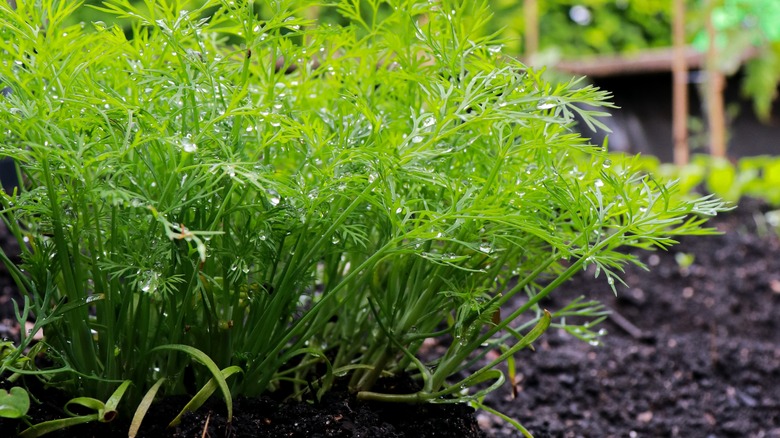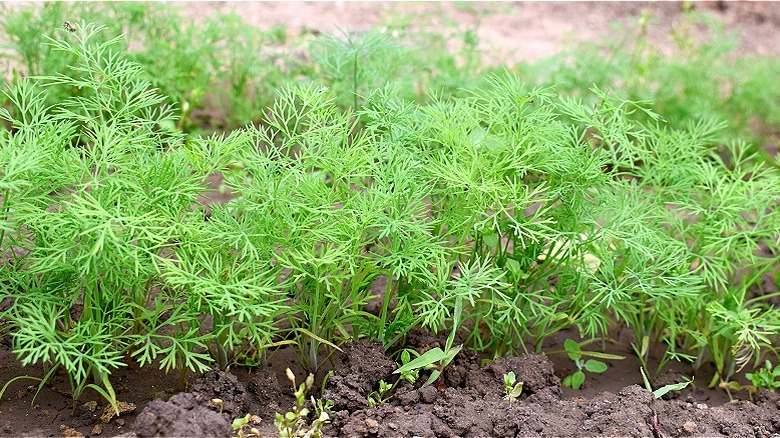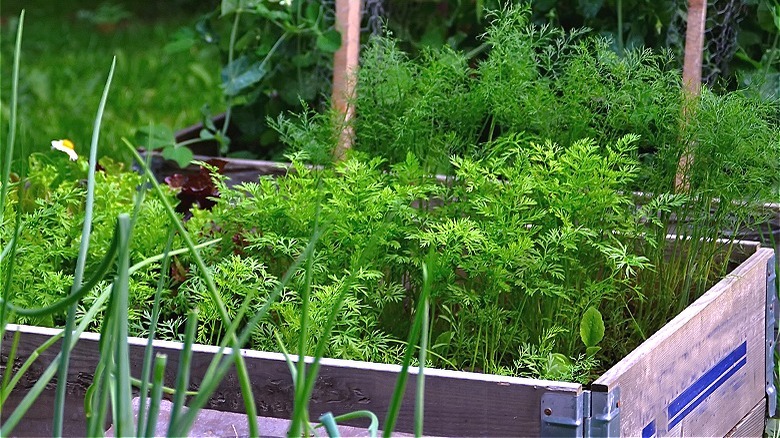You May Want To Think Twice Before Planting Dill In The Ground
Dill makes for some tasty dips, a fabulous potato salad, and an excellent topping for salmon, among its many other uses. Growing it fresh creates a fantastic opportunity to have a rich, even organic source of this herb, but be careful about where and how you plant dill. If you plant dill in the ground, such as in your garden or flowerbed, expect to spend a good amount of time managing it. This herb will grow quickly over time and spread so much that it can overtake your garden.
You can still grow dill at home and may even want to grow it on a windowsill in your kitchen with other herbs. The key to doing so, though, is to keep it somewhat contained, such as growing it in a pot. That limits the spread of the plant without causing any risk to its ability to thrive. This doesn't mean, though, that a tiny pot is going to be enough room for it. Dill needs its own space to continuously grow and keep up with demand. It can grow as high as 4 feet, depending on the variety.
If you want to grow dill to have it conveniently on hand, you'll need to create the ideal environment (even in the ground) to limit its spread. Once you create the right space for it, it's not a difficult herb to maintain either.
How to grow dill in a contained space
Growing dill in the ground is an option if you limit the space the plant has to spread. For those who are creating an outdoor herb garden, give dill its own location, one with ample room, such as a few square feet of space, and borders to keep it from spreading beyond that space. You may want to use rock or paving stones to create the border, limiting the dill plant's overall ability to move beyond that area.
Since dill is an annual plant, you'll likely grow it from seed. Don't overseed the area, though, as it'll likely grow quickly in the right soil environment and then spread outward. It's a good idea to plant them in rows within that space, keeping them about 6 inches from row to row and about 2 inches from seed to seed.
Then keep an eye on it as it grows. The dill seeds begin to germinate in about a week or two and will reach a foot tall within a matter of a few weeks. The key to controlling dill in the ground is to keep it thinned, which will also help to ensure a healthy level of growth with flavorful results. Start thinning the plants down to a handful of the heartiest seedlings when about 4 inches tall, and then do the same when they reach 12 inches tall.
There are other options for controlling dill
An alternative to planting dill in the ground is to use pots instead. This also gives you the flexibility to move the plant(s) from time to time. Since dill encourages beneficial insects, you could, for example, move the pots from one area of the garden to the next to bring in the pollinators you need. Also, keep those plants near your cabbage and broccoli to keep pests at bay; dill can be an excellent companion plant in this way.
If you want to grow dill in a container garden, ensure it has room. This plant needs a good foot or more of space for a few seeds to grow and do well since it naturally likes to spread out. Choose a larger pot and, when possible, aim for a longer garden-style trough rather than a small, round container. That longer space allows you to space out the dill seeds. You can also use a raised bed to grow dill, as long as the soil is of higher quality and you keep it thinned.
Make sure to harvest your dill as well. Most often, this takes up to 90 days from seed to reach full harvest. When harvesting, cut the plants back to leave 6 to 9 inches of the ferns in place to encourage regrowth. Harvesting, thinning, and containing make dill an excellent garden herb to grow. Not taking these steps, however, and allowing dill in the ground to spread could spell garden trouble.


